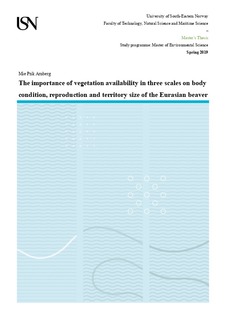The importance of vegetation availability in three scales on body condition, reproduction and territory size of the Eurasian beaver
Master thesis
Published version
Permanent lenke
http://hdl.handle.net/11250/2610995Utgivelsesdato
2019Metadata
Vis full innførselSamlinger
Sammendrag
Availability of food resources can affect body condition and reproduction in animal populations as low food availability can lead to decreasing body condition and constrain reproduction. At the same time, spatial distribution and abundance of vegetation can affect movement and space use of animals thus affecting territory size. I quantified territory-specific composition of habitat types and availability of tree and plant (i.e. herbs, grasses and saplings) communities in ten beaver (Castor fiber) territories along two rivers in Telemark county, Norway during the summer of 2018. Further, I investigate the effect of vegetation availability within territories on body condition, reproduction and territory size of the beavers. Males and females showed a sex-dependent response in body condition to availability of vegetation. The body condition of females was positively influenced by increasing forest cover and abundance of deciduous trees and negatively influences by increasing grassland cover within a territory while males remained largely unaffected. No scale of vegetation availability impacted reproduction of the beavers and reproduction were rather influenced by previous reproduction, maternal age, and family density. Beavers adjusted territory size to avoid resource depletion as they had increasing territory size when abundance of larger deciduous trees increased. Sex-dependent differences in food selection by monomorphic species, such as the beavers, have been little explored. Further, beaver’s capital breeder behavior and the impact of temporal nutrient variation in forage species, deserves more attention in the future to better understand factors controlling body condition and reproduction in beavers.
